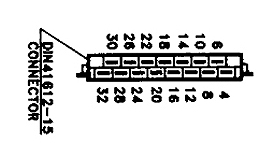Amtex are a well known power supply distributor in Australia, due to expansion of the company they underwent a restructuring and name change in 2016 and are now known as Helios Power Solutions
THIS SMPS IS USED BUT FULLY OP TESTED, WORKING FINE
Ex Broadcast industry rack sub-frame equipment
Amtex (Helios Power Solutions)
Model: HSU100-49*
* I believe this was a special OEM build for Provideo, the designer and manufacturer of the broadcast equipment contained in this sub-frame. I cannot find any documentation relating to this specific -49 model.
Made in Taiwan
230-240V AC input
This input is applied to Pins 28 (Active) & Pin 30 (Neutral)
Power ON front panel LED (Green)
Quad output capable
Industrial reliability 40,000 MTBF (Mean Time Between Failure) when running at typical ambient temperatures in the range 0 ~ 50C
ID Label identifies the outputs as:
VO1: +8V @ 6A (Pin 4)
VO2: -8V @ 6A (Pin 10)
VO3: +15V @ 3A (Pin 12)
VO4: -15V @ 3A (Pin 18)
Total SMPS power dissipation should not exceed 100 Watts but the HSU-100 series has inbuilt protection when the average power rating exceeds 125 ~ 150% of the rated power, also short circuit protection.
AC Ripple at any output does not exceed 1% P-P
Convection cooled (no fans)
Extremely well cased, user protection was a key priority with these SMPS, due to their intended use in Euro sub-frames
DIN41612 Euro connector (male) input & outputs.
COSMETIC CONDITION:
Excellent, no signs of SMPS stress at all
The front panel plate (removable) has been screen printed with the manufacturers logo (PV)
There is also a pull handle (the Ejector) fitted
Only 2x screws secure this front panel, it can easily be removed by the user if desired and a new front panel fitted.
TESTING:
First up, it is very important that the user makes themselves familiar with the DIN41612 pinout of this connector, to connect line AC input to the wrong pins would be a disaster. I have attached a photograph of both the physical dimensions but also the DIN connector pinout, this is extremely important and you WON'T find the pin numbers marked on the EPT 113-40060 H15 Series DIN41612 connector!
Australian 240V 50Hz AC line input is applied to Pins 28 (Active) & Pin 30 (Neutral) ONLY

ALL DC output voltages are fine, no problems at all.
I have multiple units and tested every single unit
However I have made some "special" notes because I found the documentation not too clear, in particular where on earth the DC COMMON points were! See my notes below.
There are other special functions available on the SMPS which I have not tested. My testing comprised of testing every single SMPS output voltage and that they were within design tolerances.
The other special function pins are:
Logic Inhibit: Pin 20
Power Fail (this is optional): Pin 22
SW: Pin 24
NOTES RELATING TO THE DC OUTPUTS:
Each output is exactly as it should be, for example if I measure across VO1 & VO2 I have 16V with VO1 being positive. Same goes for VO3 & VO4 measuring 30V with VO3 being positive. Not documented on the ID label or anything I could find online was a DC common. It certainly isn't pin 32, that is the SAFETY GROUND and not to be used as a dc ground point. In fact if you measure between any output and this safety ground, the voltage almost immediately slides rapidly down to zero.
I then found the following, IT IS UP TO THE USER TO CONFIRM THESE MEASUREMENTS AND DECIDE WHICH PINS TO USE
Pin 6 looks to be a DC Common pin. If I measure between Pin 4 & Pin 6 I measure +8V
Pin 8 looks to be a DC Common pin. If I measure between Pin 10 & Pin 8 I measure -8V
I measure 0 volts between Pins 6 & 8
Same sort of pattern follows for the 15V rails
Pin 14 looks to be a DC Common pin. If I measure between Pin 12 & Pin 14 I measure +15V
Pin 16 looks to be a DC Common pin. If I measure between Pin 16 & Pin 18 I measure -15V
I measure 0 volts between Pins 14 & 18
This power supply is a nice basis for a wide range of rack sub-frame electronic equipment and cards with the +/- 8V and +/- 15V supplies or forget the DC common points and you have ready access to 16V and 30V supplies, single rail. Daughter cards could be fitted to the rear of the HSU-100 to allow for voltage changing/regulation such as creating a 5V supply and perhaps additional filtering or even voltage alarm facilities should the supply "misbehave"
















